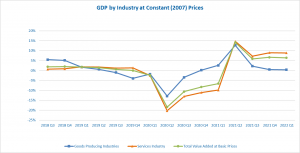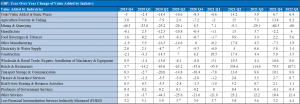July 1, 2022
According to the Statistical Institute of Jamaica (STATIN), the total value added at constant prices for the Jamaican economy grew by 6.4 per cent in the first quarter of 2022 when compared to the similar quarter of 2021. This was 0.4 per cent higher than the Planning Institute of Jamaica’s (PIOJ) estimated growth of 6.0 per cent for the quarter. This was attributed to growth in both the Services and Goods Producing Industries of 8.9 per cent and 0.4 per cent respectively. Favourable weather conditions and the easing of COVID-19 containment measures during the period contributed to the performance of the economy. Additionally, the withdrawal of the Disaster Risk Management Order on March 18, 2022 positively impacted economic activity.


Growth was recorded in all the Services Industries: Hotels & Restaurants (107.1%), Wholesale & Retail Trade; Repairs; Installation of Machinery & Equipment (8.8%), Transport, Storage & Communication (8.8%), Other Services (12.4%), Finance & Insurance Services (0.7%), Real Estate, Renting & Business Activities (1.1%), Producers of Government Services (0.4%) and Electricity & Water Supply (1.4%).
Growth in the Hotels & Restaurants industry resulted from growth in hotels & other short-stay accommodation and restaurants, bars & canteens. The hotels & other short-stay accommodation group was impacted by a 230.1 per cent increase in foreign national arrivals. A total of 475,805 foreign nationals visited the island during the period, compared to 144,139 in 2021. The higher total was influenced by increased arrivals from the United States of America (160.1%), Canada (1,433.8%) and Europe (8,773.1%).
The growth in the Other Services industry was due to growth in both the recreational, cultural & sporting activities and other services sub-industries. The increase in recreational, cultural & sporting activities was mainly due to growth in tourist-related activities, other entertainment activities and betting & gaming activities. Tourist-related activities benefitted from increases in stopover and cruise passenger arrivals to the island. Stopover arrivals moved to 510,401 in 2022 from 161,275 in 2021, representing a 216.5 per cent increase. A total of 99,798 cruise passengers visited the island in 2022, compared to 2021 when there were no arrivals as the piers were closed to limit the spread of COVID-19.
The uptick in the Transport, Storage & Communication industry was influenced by growth in the transport and post & telecommunications sub-industries. The transport subindustry benefitted from the revocation of the work-from-home order and the full resumption of schools. In addition, cruise ship piers reopened following their closure in 2020 to limit the spread of COVID-19. There was also an increase in the number of passengers travelling through the nation’s airports. The growth in post & telecommunications was largely due to the increase in telephone services.
The Electricity & Water Supply industry’s increase was the result of growth in both electricity consumption (1.7%) and water consumption (0.2%). Electricity consumption moved to 737,496 MWh in 2022 from 725,074 MWh in 2021, mainly due to increased usage by commercial entities. Water consumption increased to 4,727.7 million gallons in 2022 from 4,716.7 million gallons in 2021, primarily attributed to increased consumption by schools and commercial consumers.
The Wholesale & Retail Trade; Repairs; Installation of Machinery & Equipment industry growth was attributable to higher output levels in the Agriculture, Manufacturing and Construction industries. Additionally, higher consumer demand would have resulted from the increase in the employed labour force and the revocation of the Disaster Risk Management Order.
The Real Estate, Renting & Business Activities industry’s growth was due to increases in both the business activities and real estate sub-industries. The main contributors to the growth in the business activities sub-industry were the groups: renting of other machinery and equipment, other business services n.e.c. and land transport equipment without operator. The growth in renting of other machinery and equipment was impacted by increased construction activities.
The Finance & Insurance Services industry’s growth was influenced by increases in the monetary intermediation and other financial intermediation sub-industries. The increase in the monetary intermediation sub-industry was primarily attributed to improved performance in commercial banks and building societies. The increase in interest income, fees and commissions contributed to the performance of commercial banks. However, the insurance services sub-industry fell for the period.
Within the Goods Producing Industries, higher output levels were recorded for Agriculture, Forestry & Fishing (8.2%), Manufacturing (4.0%) and Construction (3.5%). However, Mining & Quarrying declined by 60.0 per cent.
Growth in Agriculture, Forestry & Fishing was the result of increases in both sub-industries, Other Agricultural Crops (which includes Animal Farming, Forestry & Fishing) and Traditional Export Crops of 8.4 per cent and 7.1 per cent respectively. The major contributory factors influencing the increase were favorable weather conditions and the continuation of the Production Incentive Programme initiated by the Government to increase crop production.
The uptick within the Manufacturing industry was due to increases in both the Food, Beverages & Tobacco and Other Manufacturing sub-industries of 5.6 per cent and 1.9 per cent respectively. The sub-industry benefitted from increased demand from the hotels and restaurants industry and from schools. The Construction industry growth was mainly due to increased activities in building construction and civil engineering. Higher expenditure on the South Coast Highway Improvement Project contributed to the performance of the civil engineering group. While the contraction
However, the decline within the Mining & Quarrying industry was primarily attributed to lower output levels of alumina and crude bauxite. Alumina production continued to be impacted by the closure of the Jamaica Aluminium Company (JAMALCO) plant as a result of the fire that occurred in August 2021. The production of alumina fell by 74.3 per cent to 103.5 thousand tonnes in 2022, compared to 402.7 thousand tonnes in 2021.
Notably, total value added fell by 1.2 per cent when compared to the fourth quarter of 2021. The economy grew by 8.2 per cent for the fiscal year 2021/2022 compared to the fiscal year 2020/2021, reflecting the increase in economic activity influenced by the relaxation of COVID19 measures.

Disclaimer
Company Disclosure -The information contained herein has been obtained from sources believed to be reliable, however, its accuracy and completeness cannot be guaranteed. You are hereby notified that any disclosure, copying, distribution, or taking any action in reliance on the contents of this information is strictly prohibited and may be unlawful. Mayberry may effect transactions or have positions in securities mentioned herein. In addition, employees of Mayberry may have positions and effect transactions in the securities mentioned herein.
